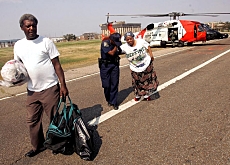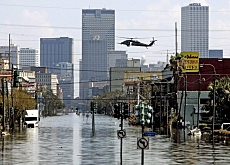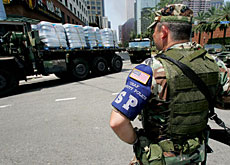Specialist helps diabetes sufferers in Louisiana

A Swiss diabetes expert has come to the rescue of hundreds of victims of Hurricane Katrina in the state of Louisiana.
Recognising that many had fled their homes without taking vital medicine, Professor Eric Ravussin set up an emergency diabetes clinic that now covers at least 40 shelters across the state.
Within days of the hurricane striking the southern coast of the United States, Ravussin and a colleague at the Pennington Biomedical Research Center in Baton Rouge decided that something had to be done for diabetes sufferers among the tens of thousands of displaced people in Louisiana.
According to the diabetes and obesity specialist, around 15 per cent of the population in the shelters were suffering from the condition. At the end of the week there were more than 48,000 people housed in shelters in the state.
“On the Wednesday after the hurricane, the first families started arriving in Baton Rouge and we decided to set up a diabetes relief operation. We began asking around for money and insulin,” Ravussin told swissinfo.
“Two days later we went out to a shelter in Baton Rouge where there were 6-7,000 people. We found there were many people without medication because they had had to leave it behind.”
State shelters
Ravussin, who comes from Lausanne, immediately put together a team of two doctors and two nurses to begin distributing blood-sugar tests and insulin in the shelter.
A week later around 50 volunteer medical personnel were bringing diabetes relief to 40 shelters around the state.
After more than ten days working on the frontline, the Swiss professor is now handing over the running of the operation to the American Red Cross.
“If you don’t treat people with diabetes, things can become very difficult… People suffer hyper- or hypoglycaemic attacks,” he said.
“We saw one lady at a shelter who could not speak. She was a wreck, so we tested her blood-sugar level and treated her.”
Ravussin and his wife, Jacqueline, also opened their home in Baton Rouge to two Swiss families who had fled New Orleans ahead of the hurricane.
Offering shelter
They also provided a roof for a neighbour and a menagerie of dogs, cats and reptiles. At one point there were 12 adults and children at the Ravussin house.
“It was quite a squeeze, but it meant that every night we had a big dinner party,” said Ravussin. “Sometimes we didn’t go to bed until after midnight and then I was up at 5am to go out to the shelters. Right now I’m exhausted.”
Marie-Michele Agid, who originally hails from Lausanne, is one of those who found a roof at the Ravussins’ after fleeing New Orleans hours before the hurricane struck two weeks ago.
Her husband Gérard is the food and beverage director at the Holiday Inn next to the city’s airport.
“When we left we really did not know what to think because we also had to evacuate last year,” said Agid. “You have to think about so many things – there is a lot going through your mind.”
Fleeing the hurricane
The Agid family drove up to Baton Rouge in three cars, after securing their house in the Kenner district of New Orleans as best they could.
When Marie-Michele returned for the first time on Tuesday she was relieved to find that the damage to their home was not as severe as she had feared.
“All the ground floor was covered with water. We had about two feet in one room,” she said. “Right now we are not supposed to go back for two to three weeks but we think it will be quicker than that. On Friday there was electricity in the house and the phone was working.”
The Agids’ elder son, who was due to start at New Orleans’ Loyola University, has now begun classes at Louisiana State University in Baton Rouge instead.
“This has been a very stressful experience – not just for us but for hundreds of thousands of other people,” she said.
“It’s going to take a long time before New Orleans can get back on its feet – there has been so much destruction. Clearing up all the mess and contamination – everything that’s in the water – is going to be a monumental task.”
swissinfo, Adam Beaumont in Baton Rouge, Louisiana
US Army engineers have projected it will take a month to dry out New Orleans, which was 80 per cent covered following the storm and flooding.
Ten days after Hurricane Katrina, New Orleans officials said rescuing the stranded and the helpless had ended and efforts were now turned to finding bodies.
Some US federal officials have put the cost of the storm at between $100 billion (SFr124 billion) and $200 billion.

In compliance with the JTI standards
More: SWI swissinfo.ch certified by the Journalism Trust Initiative


You can find an overview of ongoing debates with our journalists here . Please join us!
If you want to start a conversation about a topic raised in this article or want to report factual errors, email us at english@swissinfo.ch.